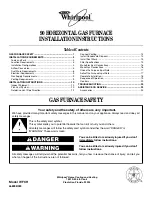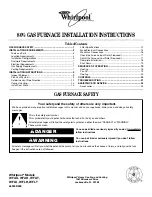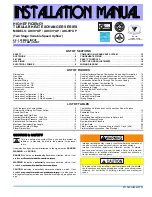
16
Altitude
Gas
Kit
Orifice
Manifold
Pressure
Pressure
Switch
#55
10.0" w .c.
0 - 5500
Natural
None
#45
3.5" w .c.
None
Propane LPT-03
Gas Piping Connections
WARNING
To avoid possible unsatisfactory operation or equipment
damage due to underfiring of equipment, use the proper size
of natural/propane gas piping needed when running pipe from
the meter/tank to the furnace.
When sizing gas line, be sure to include all appliances which
will operate simultaneously.
The gas piping supplying the furnace must be properly sized
based on the gas flow required, specific gravity of the gas,
and length of the run. The gas line installation must comply
with local codes, or in their absence, with the latest edition of
the National Fuel Gas Code, NFPA 54/ANSI Z223.1.
Natural Gas Capacity of Pipe
In Cubic Feet of Gas Per Hour (CFH)
Length of
Nominal Black Pipe Size
Pipe in Feet
1/2"
3/4"
1"
1 1/4"
1 1/2"
10
132
278
520
1050
1600
20
92
190
350
730
1100
30
73
152
285
590
980
40
63
130
245
500
760
50
56
115
215
440
670
60
50
105
195
400
610
70
46
96
180
370
560
80
43
90
170
350
530
90
40
84
160
320
490
100
38
79
150
305
460
(Pressure 0.5 psig or less and pressure drop of 0.3" W.C.; Based on
0.60 Specific Gravity Gas)
CFH =
BTUH Furnace Input
Heating Value of Gas (BTU/Cubic Foot)
To connect the furnace to the building’s gas piping, the in-
staller must supply a ground joint union, drip leg, manual
shutoff valve, and line and fittings to connect to gas valve. In
some cases, the installer may also need to supply a transi-
tion piece from 1/2” pipe to a larger pipe size.
The following stipulations apply when connecting gas piping.
•
Use black iron or steel pipe and fittings for the building
piping.
•
Use pipe joint compound on male threads only. Pipe
joint compound must be resistant to the action of the
fuel used.
•
Use ground joint unions.
• Install a drip leg to trap dirt and moisture before it can
enter the gas valve. The drip leg must be a minimum
of three inches long.
•
Install a 1/8” NPT pipe plug fitting, accessible for test
gage connection, immediately upstream of the gas
supply connection to the furnace.
•
Use two pipe wrenches when making connection to
the gas valve to keep it from turning. The orientation of
the gas valve on the manifold must be maintained as
shipped from the factory.
•
Install a manual shutoff valve between the gas me
-
ter and unit within six feet of the unit. If a union is
installed, the union must be downstream of the man-
ual shutoff valve, between the shutoff valve and the
furnace.
• Tighten all joints securely.
• Connect the furnace to the building piping by one of
the following methods:
– Rigid metallic pipe and fittings.
– Semi-rigid metallic tubing and metallic fittings. Alumi
-
num alloy tubing must not be used in exterior loca-
tions.
– Use listed gas appliance connectors in accordance
with their instructions. Connectors must be fully in the
same room as the furnace.
– Protect connectors and semi-rigid tubing against
physical and thermal damage when installed. Ensure
aluminum-alloy tubing and connectors are coated to
protect against external corrosion when in contact
with masonry, plaster, or insulation, or subjected to
repeated wetting by liquids such as water (except rain
water), detergents, or sewage.
Drip Le
g
Ground Joint Pipe Union
To Be Installed
Ahead of Gas Valve
OPTIONAL:
Reducing Coupling
1/2” x 1/8” with 1/8”
Pipe Plug to Measure
Line Gas Pressure
Height Required
By Local Code
Location of Manual Valve
(Installed Ahead of
Ground Joint Pipe Union)
General Furnace Layout
Upflow Installations
A ground joint union, drip leg, and manual shutoff valve must
also be supplied by the installer. In some cases, the installer
may also need to supply a transition piece from 1/2” to another
















































